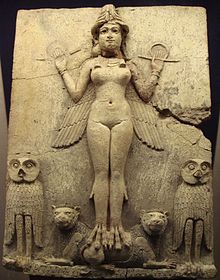This article needs additional citations for verification. (January 2022) |
The rod-and-ring symbol is a symbol that is depicted on Mesopotamian stelas, cylinder seals, and reliefs. It is held by a god or goddess and in most cases is being offered to a king who is standing, often making a sacrifice, or otherwise showing respect. The symbol dates from the Third Dynasty of Ur to the Neo-Assyrian period, and is commonly explained as a coil of measuring string and a yardstick.[1] Other theories are that they are a shepherd's crook and a nose rope,[2] or that the ring is no rope at all.[3]


The best known example of the symbol is seen on the Code of Hammurabi stela. The symbol is also illustrated in the "Investiture Scene" painted at the palace of Mari.[4] The most elaborate depiction is found on the Ur-Nammu-stela, where the winding of the cords has been detailed by the sculptor. This has also been described as a "staff and a chaplet of beads".[5] There is discussion whether the Ur-Nammu-stela is showing the same thing.
Scepter, throne, and ring: Enuma Elish
editThe myth of Inanna's descent to the nether world describes how the goddess dresses and prepares herself: "She held the lapis-lazuli measuring rod and measuring line in her hand."[6]
In tablet IV of the Enuma Elish, the rod and ring symbol is referenced as:
Symbols that appear similar
edit- The Egyptian shen ring has a close resemblance. [citation needed]
- The Greek goddess Nike uses a different type of investiture symbol for the victor in the sporting races, a wreath of laurel, or a wreath of olive branches, but she is depicted with a ring, a rigid circle. [citation needed]
- The Faravahar, the symbol of Zoroastrianism, also holds a ring. [citation needed]
- The Egyptian Ankh has a vaguely similar form and is also depicted in hands of gods.[8]
Notes
edit- ^ Jacobsen, 1987
- ^ Hallo, W.W. 2005. Sumerian history in pictures: a new look at the 'Stele of the Flying Angels', in: Y. Sefati et al (eds), 'An Experienced Scribe who Neglects Nothing': Ancient Near Eastern Studies in Honor of Jacob Klein. Bethesda, MD: CDL Press, 142-62.
- ^ Van Buren, E.D. 1949. The rod and ring. ArO 17 (2), 434-50.
- ^ Knott, Elizabeth (2021-09-21), "Mari's Investiture Scene and the Visualization of Kingship in the Old Babylonian Period", As Above, So Below, Penn State University Press, pp. 74–114, doi:10.5325/j.ctv1xx9msm.7, ISBN 9781646021536, S2CID 240527251, retrieved 2022-12-17
- ^ Jeremy Black, Anthony Green, Gods, Demons and Symbols of Ancient Mesopotamia, Rod and Ring, p 156.
- ^ cf. Inana's descent to the nether world line 25. The Sumerian has: gi-diš-nindan eš2-gana2 za-gin3 šu ba-ni-in-du8 i.e. taken literally the rod would have the length of one nindan (6 cubit = 5.94m) and the eš2-gana2 the surveyor's line - would be ten nindan in length.
- ^ Enuma Elish, tablet IV
- ^ Hill, Jane A. (2010). "Window between Worlds: The Ankh as a Dominant Theme in Five Middle Kingdom Funerary Monuments". In Hawass, Zahi; Wegner, Jennifer Houser (eds.). Millions of Jubilees: Studies in Honor of David P. Silverman. American University in Cairo Press. pp. 227–247. ISBN 978-977-704-084-6.
References
edit- Black, Jeremy; Green, Anthony. Gods, Demons and Symbols of Ancient Mesopotamia, an Illustrated Dictionary, by Jeremy Black and Anthony Green, c 1992, (3rd printing 1997), University of Texas Press, Austin, p 156 (softcover, ISBN 0-292-70794-0)
- Jacobsen, Thorkild (1987) "Pictures and pictorial language (the Burney Relief)". In: M. Mindlin, M.J. Geller and J.E. Wansbrough, eds., Figurative Language in the Ancient Near East, 1-11. (1987) London: University of London School of Oriental and African Studies. ISBN 0-7286-0141-9
- Arthur E. Whatham, The Meaning of the Ring and Rod in Babylonian-Assyrian Sculpture, The Biblical World, Vol. 26, No. 2 (Aug., 1905), pp. 120–123.
-
Scene detail of Code of Hammurabi monumental stela
-
Scene and cuneiform inscriptions–(upper half of stela)
External links
edit- Inana's descent to the nether world at Electronic Text Corpus of Sumerian Literature
- The Enûma Elish